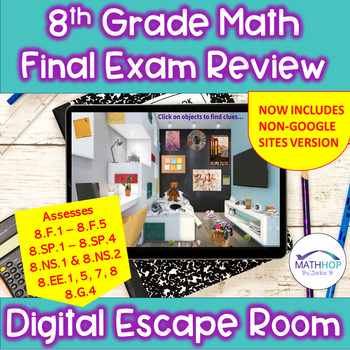8th Grade Math End of Year Final Exam Review Digital Escape Room
- Zip
- Google Apps™
- Internet Activities

What educators are saying
Also included in
- Need ENGAGING & SELF-CHECKING Digital Escape Rooms for ALL critical 8th grade math topics? This bundle includes 12 different digital escape rooms covering essential topics including a first week review escape room (review of 7th grade topics), a midterm review, and final exam review. Use throughPrice $64.00Original Price $79.00Save $15.00
Description
End of Year Review! A Digital & Fun way for math students to review for their 8th Grade Math Final Exam. NO Prep needed; students will be completely engaged. Students click on objects around the room to find and solve clues and then enter their answers into the lock to "escape". Reviews 8th grade functions, expressions & equations, statistics & probability, & number systems standards. Perfect supplemental activity to give 8th graders towards the end of the year and before any final exam.
NON Google Sites Version Now Included!
Questions assess these common core standards:
8.NS.1, 8.NS.2
8.F.1, 8.F.2, 8.F.3, 8.F.4, 8.F.5
8.EE.1, 8.EE5, 8.EE.7, 8.EE.8
8.SP.1, 8.SP.2, 8.SP.3, 8.SP.4
8.G.4
Would make an excellent activity for first week Algebra students to review key 8th grade topics. INCLUDED: Editable PDF for students to fill out their answers to each clue and turn in either digitally or in-person & a digital clues tracking sheet.
Try this NO PREP digital math escape room with your students today!
Watch A Video Preview of This Escape Room!
8th Grade Final Exam Review Digital Escape Room!
NOW INCLUDED: Digital Clues Sheet for students to track their progress without pencil & paper.
Topics Included:
✨ Determine Linear Functions from a Table
✨ Determine if a Relation is a Function
✨ Determine Rate of Change
✨ Solve Word Problems Using the Pythagorean Theorem
✨Determine Equivalent Expressions
✨ Simplify Expressions Using Properties of Exponents
✨ Interpret Data in a Two-Way Table
✨ Solve Systems of Linear Equations from a Graph
✨ Determine Slope of a Line
✨ Graph Linear Equations
✨ Identify Irrational Numbers & Estimate Location on a Number Line
✨ Solve Word Problems Involving Sales Tax
✨ Determine Correlation from a Scatterplot & Describe Lines of Best Fit
✨ Compare Two Functions Represented Two Different Ways
✨ Evaluate Perfect Cubes
✨ Analyze Graphs of Functions (linear, nonlinear, increasing, decreasing)
☀️This is a Google Sites Escape Room
⭐ Step by step instructions are included, although since this is a DIGITAL ESCAPE ROOM, there is NO Prep & it is ready to go.
⭐ A digital copy of the PDF with the clues is included so you can have students print it to turn it in or submit it electronically.
⭐ A link to the embedded lock is included so you can see student responses.
⭐ Can be done in class or given as a remote learning assignment. This is sure to capture the attention of your students.
✨You will get a PDF with all instructions & access to the Digital Escape Room. ✨
Follow Me! to be notified about my products, sales, updates, and FREEBIES!
Connect with Me!
Use Hundreds of my Math Videos in Your Class!
Check out my custom course materials:
I WOULD LOVE YOUR FEEDBACK!
Remember to leave feedback and you will earn points toward FREE TPT purchases. I love your feedback!
LICENSING TERMS: This purchase includes a license for one teacher only for personal use in their classroom. Licenses are non-transferable, meaning they cannot be passed from one teacher to another. No part of this resource is to be shared with colleagues or used by an entire grade level, school, or district without purchasing the proper number of licenses. If you are a coach, principal, or district interested in transferable licenses to accommodate yearly staff changes, please contact me for a quote at MathHop321@gmail.com.
COPYRIGHT TERMS: This resource may not be uploaded to the internet in any form, including classroom/personal websites or network drives, unless the site is password protected and can only be accessed by students.





